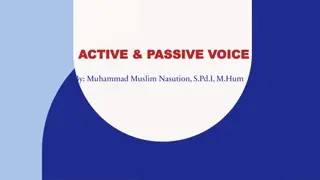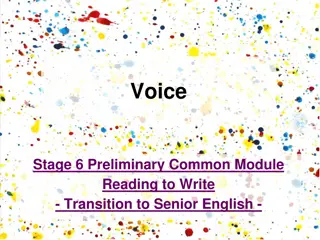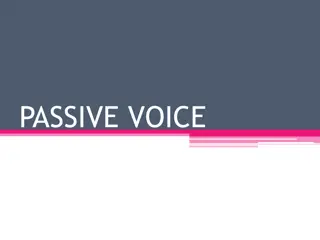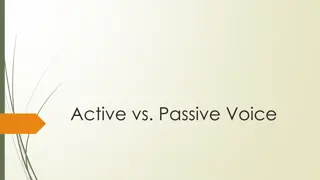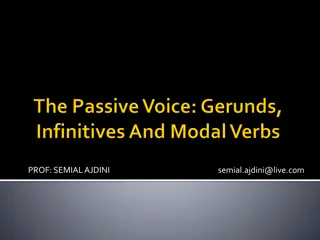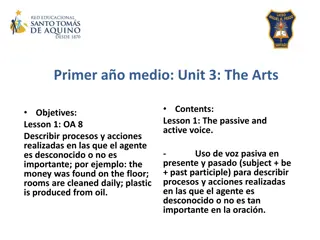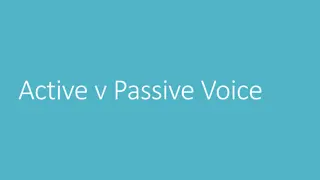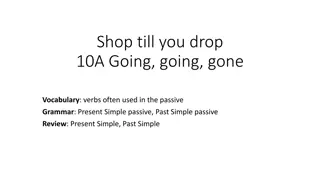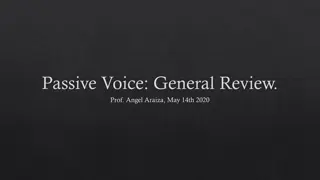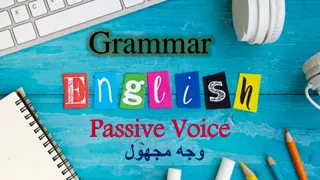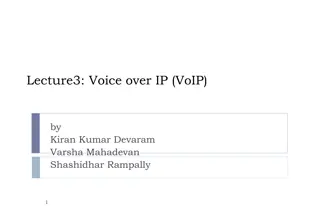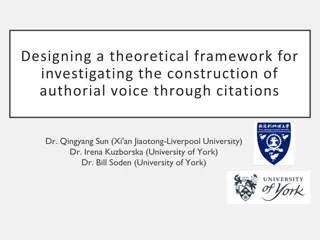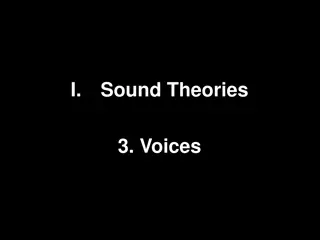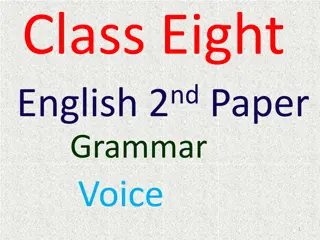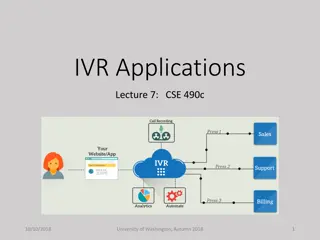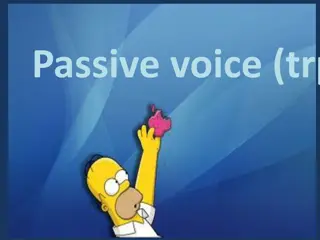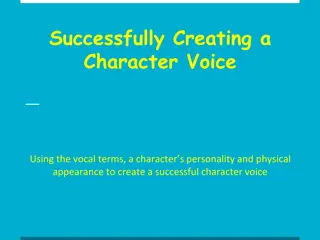Enhancing Student Engagement Through Student Voice and Collaboration
Explore best practices for student-centered approaches in higher education, emphasizing the importance of student engagement, partnership, and active involvement in shaping their learning experiences. Discover how students' voices, contributions, and collaborations can lead to increased motivation, commitment, and overall success in academia.
Download Presentation

Please find below an Image/Link to download the presentation.
The content on the website is provided AS IS for your information and personal use only. It may not be sold, licensed, or shared on other websites without obtaining consent from the author.If you encounter any issues during the download, it is possible that the publisher has removed the file from their server.
You are allowed to download the files provided on this website for personal or commercial use, subject to the condition that they are used lawfully. All files are the property of their respective owners.
The content on the website is provided AS IS for your information and personal use only. It may not be sold, licensed, or shared on other websites without obtaining consent from the author.
E N D
Presentation Transcript
Student Engagement through Student Voice and Student-Faculty Pedagogical Partnership Best Practices in Student-Centred Approaches 20 November 2018 Alison Cook-Sather, Mary Katharine Woodworth Professor of Education, Bryn Mawr College, and Director, Teaching and Learning Institute, Bryn Mawr and Haverford Colleges, Pennsylvania, USA acooksat@brynmawr.edu
Student Engagement the opposite of alienation (Mann, 2008) layered and meaningful participation in, and commitment to, learning (Kuh et al. 2010) involvement, excitement and persistence (Ahlfeldt et al. 2005; Schlechty, 2011; Nygard et al., 2013) critical participation as opposed to compliance and questioning as opposed to answering (Nixon, 2012) emotional as well as intellectual investment (Cook- Sather, 2014) Students get the most out of university through finding the relationships that are most energizing and motivating (Chambliss & Takacs, 2014)
Research findings on the importance of engagement to student learning and success Drawing on Fromm s (1978) argument that higher education is about becoming, not having, Solomonides et al. (2012) emphasize students whole sense of being in relation to engagement (see Bryson, 2014). Without strong engagement, students do not optimize their potential during and after their experience in higher education (Bryson, 2014; Felten et al., 2016; Hardy & Bryson, 2016; Nygaard, Bartholomew, Brand, & Millard, 2013). engagement activities give students a sense of being, belonging and becoming as well as feeling part of their institutions (Neary, 2016)
Calls to rethink students role If there is to be a single important structural change during the coming decades, it is the changing role of students who are given more room in defining and contributing to higher education (G rdebo & Wiggberg, 2012, p. 9). [Sweden] Engaging students and staff effectively as partners in learning and teaching is arguably one of the most important issues facing higher education in the 21st century (Healey, Flint, & Harrington, 2014, p. 7). [England] not all [students-as-partners (SaP) work] is genuine partnership and our collective efforts within the SaP community should be focused on a pathway toward authentic formations of partnership spaces (Dwyer, 2018, p. 14) [Australia]
Student Voice in Higher Education Having a seat at the proverbial table (student quoted in Cook-Sather & Agu, 2013) Speaking to and being listened to by faculty and others making decisions about curriculum and pedagogy Being a Student Consultant gave me voice when I was not in the role of student consultant (student quoted in Cook-Sather & Agu, 2013) In their own classes, in other relationships, etc. Shaping what happens in classrooms and also offering conceptual frames and arguments in scholarship (Cook- Sather, 2018) resistance and resilience (Ntem & Cook-Sather, 2018) epistemic justice (de Bie et al., forthcoming)
What is pedagogical partnership? A collaborative, reciprocal process through which all participants have the opportunity to contribute equally, although not necessarily in the same ways, to curricular or pedagogical conceptualization, decision making, implementation, investigation, or analysis (Cook-Sather, Bovill, & Felten, 2014, pp. 6-7) Enacted within an ethic of reciprocity : a process of balanced give-and-take not of commodities but rather of contributions: perspectives, insights, forms of participation (Cook-Sather & Felten, 2017, p. 181)
Students as Learners and Teachers (SaLT) Created in 2006 Semester-long, one-on-one partnerships between faculty and undergraduates not enrolled in the focal courses Student partners paid for 5-7 hours per week Components include: weekly classroom observations by student partners; weekly meetings between student and faculty partners; weekly meetings of all student partners and program director Emphasis on bringing different perspectives into dialogue
Key components of SaLT Basic design developed in collaboration with faculty and students e.g., student chose the title Student Consultants for their role Piloted with faculty members who would help ensure the success of the program e.g., staff who are confident, open, respected by their peers, etc. Evolved in response to faculty interests e.g. interest in partnerships and seminars focused on developing more culturally responsive classrooms, team teaching, integration of technology, etc. Encourages regular reflection on and sharing of experiences of partnership e.g., essays in Teaching and Learning Together in Higher Education, presentations at conferences Contributes to a culture shift toward more egalitarian teaching and learning communities (Matthews, Cook-Sather, & Healey, 2018)
Research findings from SaLT (2013-present) Partnership fosters a sense of belonging Finding a place Being affirmed as oneself Making a contribution Partnership catalyzes deeper engagement Fosters important affective experiences in relation to all faculty and to fellow students Informs students academic engagement in their own classes Contributes to students sense of their evolution as active agents in their own and others development
Research findings from SaLT (2013-present) Partnership fosters a sense of belonging Finding a place Being affirmed as oneself Making a contribution
Finding a place [SaLT helped me] find a place on campus and identify more with Bryn Mawr College and get more involved ; the experience of partnership built my confidence and enthusiasm about the Bryn Mawr experience Student partner quoted in Cook-Sather, 2015 I often tell people that I would have left Haverford were it not for the SaLT program. Although this is probably an exaggeration I am now unable to test, I do feel like I owe SaLT a debt of gratitude for making me feel like an integral part of the school and its processes. -Perez-Putnam, 2016 [Student partner]
Being affirmed as oneself [SaLT was] a space of affirmation that itself is always growing and that encourages the growth of others - Student partner, Personal Communication, April 27, 2016 I feel like being a [partner] literally gave me a voice [and] made me feel like who I am is more than enough that my identity, my thoughts, my ideas are significant and valuable -Student partner quoted in Cook-Sather, 2015 [Working in partnership makes the emotional labor so many students from equity-seeking groups invest] visible, and then discussing it in the weekly meetings [with other student partners] and feeling like we are all doing this work, we re being affirmed in doing this work for this institution and for each other. -Student partner quoted in Cook-Sather, Bahti, & Ntem, under review
Making a contribution I felt like I could create change or make an impact because I was working as a partner alongside those that are typically viewed as having the power (faculty) Student quoted in Cook-Sather, 2015 I felt like a more legitimate member of the community because I contributed something to the schools [as well as did my] best to help future teachers and learners on the campus - Student partner quoted in Cook-Sather, 2015 through the SaLT program, I felt like I was not only working with this specific professor in the moment but also towards a far-away future Haverford in which all professors have had the same opportunity to think about their pedagogy within the space of the SaLT program. This made me feel like my work was important and would have a lasting impact, which contributed to my deepening connection to the school. Perez-Putnam, 2016
Research findings from SaLT (2013-present) Partnership catalyzes deeper engagement Fosters important affective experiences in relation to all faculty and to fellow students Informs students academic engagement in their own classes Contributes to students sense of their evolution as active agents in their own and others development
Fosters important affective experiences in relation to all faculty and to fellow students It made me a lot more compassionate towards my professors, more empathetic, because I saw how hard my faculty partners were working, it made me a lot less likely to disparage my own teachers and less willing to tolerate that from other people. [Student 18] [It made me] a more forgiving student little things that I thought before were cutting into discussion time or lecture time, I started to feel if it wasn t for me it was for my friend next to me. [Student 13] Becoming empathetic stopped me from disengaging from my classes, and that empathy translated to all members on campus. [Student 6]
Informs students academic engagement in their own classes Being a student consultant has allowed me to understand the rationale behind an activity or behind an assignment a lot better seeing the content as it is as a student but also going to the next level to see the pedagogical reasoning behind it has totally deepened my learning. [Student 14] [Working in partnership made me think:] How can I be a better person in the space [of the classroom] for myself and for everybody else who is also here? [Student 18] I think I feel more confident speaking to professors .... Before I would have just been this is how everyone teaches. But now I feel like I understand both how to approach a teacher about that and feel like I have something to say that s worth hearing. [Student 11]
Contributes to students sense of their evolution as active agents in their own and others development It made me feel a sense of ownership of my experience both inside the classroom and outside the classroom. [Student 12] I started to think of myself more as an advocate within classroom spaces for my peers. I began to feel I had a lot more agency and could be an agent of change within my classroom spaces. [Student 6] It s really tough for women, for women of color, for LGBTQ folks consultant, fellow, these are words not typically afforded access to people like me. So, having the experience, being able to say I do know these things, I can prove them improved my confidence, my job seeking confidence And the reason for that is programs like [SaLT]...I would not be in that same position if it wasn t for that same training and understanding. [Student 4]
From student-centered learning to student voice and student-faculty pedagogical partnership Ensure that student voices inform discussions of teaching practices as well as of learning Move toward greater reciprocity between faculty and students (premises of partnership: respect; reciprocity; and shared responsibility) Create structures that support both of the above
References and Additional Resources Ahlfeldt, S., Mehta, S., and Sellinow, T. (2005). Measurement and analysis of student engagement where varying levels of PBL methods of instruction were in use. Higher Education Research and Development, 24, 1, 5 20. Astin, A. W. (1993). What matters in college? Four critical years revisited. San Francisco: Jossey-Bass. Barnett, B., & Felten, P. (2016). Intersectionality in action: A guide for faculty and campus leaders for creating inclusive classrooms and institutions. Stylus Publishing. Bryson, C. (Ed.) (2014). Understanding and developing student engagement. Oxon: Routledge. Carnevale, A., & Strohl, J. (2013). Separate and unequal: How higher education reinforces the intergenerational reproduction of white racial privilege (Report from Georgetown Center on Education and the Workforce). Retrieved from http://cew.georgetown.edu/separateandunequal/ Chambliss, D. F., & Takacs, G. G. (2014). How college works. Harvard University Press. Cohen, G. L., & Garcia, J. (2008). Identity, belonging, and achievement: A model, interventions, implications. Current directions in psychological science, 17, 6, 365-369. Cook-Sather, A. (2018). Listening to equity-seeking perspectives: How students experiences of pedagogical partnership can inform wider discussions of student success. Higher Education Research and Development, 37, 5, 923-936 .
Cook-Sather, A. (2015). Dialogue across differences of position, perspective, and identity: Reflective practice in/on a student-faculty pedagogical partnership program. Teachers College Record, 117, 2. Cook-Sather, A. (2014). Multiplying perspectives and improving practice: What can happen when undergraduate students collaborate with college faculty to explore teaching and learning. Instructional Science , 42, 31 46 Cook-Sather, A., & Agu, P. (2013). Students of color and faculty members working together toward culturally sustaining pedagogy. In J. E. Groccia & L. Cruz (Eds.), To Improve the Academy: Resources for Faculty, Instructional, and Organizational Development (pp. 271 285). Volume 32. San Francisco: Jossey-Bass. Cook-Sather, A., Bahti, M., & Ntem, A. (under review). Teaching and learning together in higher education: A guide for developing and supporting student-faculty partnerships focused on classroom teaching and curriculum design and redesign. Cook-Sather, A., Bovill, C., & Felten, P. (2014). Engaging students as partners in learning & teaching: A guide for faculty. San Francisco: Jossey-Bass. Cook-Sather, A., Des-Ogugua, C., & Bahti, M. (2017). Articulating identities and analyzing belonging: A multistep intervention that affirms and informs a diversity of students. Teaching in Higher Education. Cook-Sather, A., & Felten, P. (2017). Ethics of academic leadership: Guiding learning and teaching. In Frank Wu & Margaret Wood (Eds.), Cosmopolitan Perspectives on Becoming an Academic Leader in Higher Education (pp. 175-191). London: Bloomsbury Academic. Cook-Sather, A., Marquis, E., Ntem, A., & Prasad, S. K. (forthcoming). Complicating institutional roles and mobilizing cultural identities through student-faculty partnership in educational development. New Directions for Teaching and Learning.
Curran, R., & Millard, L. (2016). A partnership approach to developing student capacity to engage and staff capacity to be engaging: Opportunities for academic developers. International Journal for Academic Development, 21, 1, 67-78. http://dx.doi.org/10.1080/1360144X.2015.1120212 de Bie, A., Marquis, E., Cook-Sather, A., & Luque o, L. (in press). Valuing knowledge(s) and cultivating confidence: Contributing to epistemic justice via student-faculty pedagogical partnerships. International Perspectives in Higher Education: Strategies for Fostering Inclusive Classrooms, Volume 3. Innovations in Higher Education Teaching and Learning. Delgado-Bernal, D. (2002). Critical race theory, Latino critical theory, and critical raced- gendered epistemologies: Recognizing students of color as holders and creators of knowledge.Qualitative Inquiry, 8, 1, 105 126. doi: 10.1177/107780040200800107 Devlin, M. (2013). Bridging socio-cultural incongruity: Conceptualising the success of students from low socio-economic status backgrounds in Australian higher education. Studies in Higher Education, 38, 6, 939- 949. http://dx.doi.org/10.1080/03075079.2011.613991 Doran, J., Ferguson, A.K., Khan, G.A., Ryu, G., Naimool, D., Hanson, M.D., & Childs, R.A. (2015). What are Ontario s Universities Doing to Improve Access for Under-represented Groups? Toronto: HEQCO. http://www.heqco.ca/en-ca/Research/ResPub/ Dwyer, A. (2018). Toward the formation of genuine partnership apaces. International Journal for Students As Partners 2, 1, 11-15 . Felten, P., Gardiner, J. N., Schroeder, C. C., Lambert, L. M., & Barefoot, B. O. (2016). The undergraduate experience: Focusing on what matters most. San Francisco: Jossey- Bass. Fromm, E. (1978). The have or to be? London: Jonathan Cape.
Grdebo, J., and Wiggberg, M. (2012). Importance of Student Participation in Future Academia. In J. G rdebo and M. Wiggberg (eds.) Students, The University s Unspent Resource: Revolutionising Higher Education using Active Student Participation. Pedagogical Development Report 12. Report series from the Division for Development of Teaching and Learning. Uppsala Universitet. Hardy, C., & Bryson, C. (2016). The salience of social relationships and networks in enabling student engagement and success. Student Engagement in Higher Education Journal, 1, 1. Healey, M., Flint, A., and Harrington, K. (2014). Engagement through partnership: students as partners in learning and teaching in higher education, York: Higher Education Academy https://www.heacademy.ac.uk/engagement-through-partnership- students-partners-learning-and-teaching-higher-education Hockings, C. (2010). Inclusive learning and teaching in higher education: A synthesis of research. York: The Higher Education Academy. https://www.heacademy.ac.uk/resources/detail/resources/detail/evidencenet/Inclusi ve_learning_and_teaching_in_higher_education Kuh, G., Kinzie, J., Schuh, J. H., and Whitt, E. J. (2010). Student success in college: Creating conditions that matter. San Francisco: Jossey-Bass. Mann, S. J. (2008). Study, power and the university. Society for Research into Higher Education. Maidenhead: Open University Press.
Matthews, K. E., Cook-Sather, A., & Healey, M. (2018). Connecting learning, teaching, and research through student-staff partnerships: Toward universities as egalitarian learning communities. In V. Tong, A. Standen, A., & M. Sotiriou, (Eds.) Research Equals Teaching: Inspiring Research-based Education through Student-Staff Partnerships (pp. 23-29). London: University College of London Press. Neary, M. (2016). Raised voices: From student engagement to political engagement. Student Engagement in Higher Education Journal, 1, 1 (September). Nixon, J. ( 2012). Putting the polity back into policy: reclaiming higher education for an engaged citizenry. Symposium on Student Engagement in Higher Education. York St John University, UK. Ntem, A., & Cook-Sather, A. (2018). Resistances and resiliencies in pedagogical partnership: Student partners perspectives. International Journal for Students as Partners, 2, 1, 82-96. https://mulpress.mcmaster.ca/ijsap/article/view/3372 Nygaard, C., Bartholomew, P., Brand, S., & Millard, L. (2013). Why student engagement matters. Student engagement: identity, motivation, and community. Faringdon, England: Libri Publishing. Perez-Putnam, M. (2016). Belonging and brave space as hope for personal and institutional inclusion. Teaching and Learning Together in Higher Education, 18. http://repository.brynmawr.edu/tlthe/vol1/iss18/2 Quaye, J., & Harper, S. R. (2015). Student engagement in higher education: Theoretical perspectives and practical approaches for diverse populations, Second Edition. New York: Routledge. Ray, J., & Kafka, S. (2014, May 6). Life in college matters for life after college. GALLUP News.
Schlechty, P. (2011). Engaging students: The next level of working on the work. San Francisco: Jossey-Bass. Simmons, J., Lowrey-Hart, R., Wahl, S. T., & McBride, C. (2013, July). Understanding the African-American student experience in higher education through a relational dialectics perspective. doi:10.1080/03634523.2013.813631 Solomonides, I., Reid, A., & Petocz, P. (2012). A relational model of student engagement. In I. Solomonides, A. Reid, and P. Petocz (Eds.), Engaging with learning in higher education (pp. 11 24). Oxfordshire: Libri Publishers. Strauss, A., & Corbin, J. (1990). Basics of qualitative research: Grounded theory procedures and techniques. Newbury Park, CA: Sage. Strayhorn, T. L. (2008). The role of supportive relationships in facilitating African American males success in college. NASPA Journal, 45(1), 26-48. Tinto, V. (1993). Leaving college: Rethinking the causes and cures of student attrition (2nd ed.). Chicago, IL: University of Chicago Press. U.S. Department of Education, Office of Planning, Evaluation and Policy Development and Office of the Under Secretary. (2016). Advancing diversity and inclusion in higher education. Washington, D.C. http://www2.ed.gov/rschstat/research/pubs/advancing- diversity-inclusion.pdf


